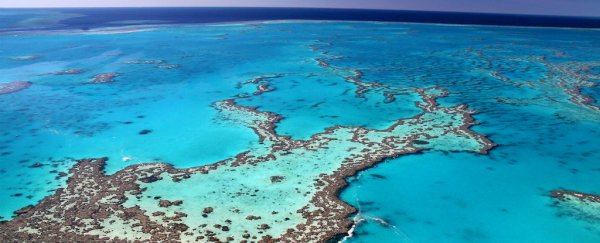Australian researchers have investigated signs of geological structures hidden behind the Great Barrier Reef in Queensland, and have found a much deeper reef spanning more than 6,000 square kilometres (2,316 square miles).
New seafloor maps of the area have revealed a vast, underwater field of doughnut-shaped mounds, each one measuring 200 to 300 metres (656 to 984 feet) across, and some as much as 30 metres deep.
Scientists have seen hints of this enormous reef for over 30 years, but until now, haven't had the chance to investigate it properly.
Fortunately, Royal Australian Navy aircraft fitted with LiDAR remote sensing technology have been flying over the area, and have finally mapped the shape, size, and vast scale of the deep reef.
"We've now mapped over 6,000 square kilometres. That's three times the previously estimated size, spanning from the Torres Strait to just north of Port Douglas," says one of the researchers, Mardi McNeil from Queensland University of Technology.
"They clearly form a significant inter-reef habitat which covers an area greater than the adjacent coral reefs."
 North-westerly view of the hidden reef. Depths are coloured red (shallow) to blue (deep), over a depth range of about 50 metres. Credit: James Cook University
North-westerly view of the hidden reef. Depths are coloured red (shallow) to blue (deep), over a depth range of about 50 metres. Credit: James Cook University
LiDAR, which stands for Light Detection and Ranging, is a surveying technology that uses lasers instead of radio waves to measure the distance of hidden formations by timing how long it takes for beams of light to hit their surface.
Used by archaeologists to reveal long-buried ruins and civilisations, the technology is also perfect for mapping underwater topography.
Scientists have now confirmed that the doughnut-shaped mounds of the Great Barrier Reef's hidden neighbour are made from Halimeda - a common type of green algae that form small limestone flakes when they die.
Nicknamed cactus algae, because it looks so much like the Australian prickly pear, Halimeda grows so fast, it leaves vast fields of limestone mounds called bioherms wherever it inhabits.
The discovery of this vast, living reef has now got researchers wondering how the effects of climate change and ocean acidification have been felt by these Halimeda populations. Unlike the life on the Great Barrier Reef, which we have decades of history to learn from, we're just beginning to get to know this ecosystem.
"For instance, what do the 10- to 20-metre-thick sediments of the bioherms tell us about past climate and environmental change on the Great Barrier Reef over this 10,000 year time-scale?" says one of the team, Robin Beaman from James Cook University in Queensland, adding that they're now going to have to figure out what kinds of life are sustained by these massive bioherms.
With a stunning 93 percent of the Great Barrier Reef having been damaged by coral bleaching earlier this year, let's hope this deep reef has a better fate.
The research has been published in Coral Reefs.
